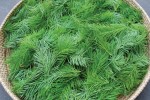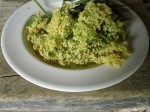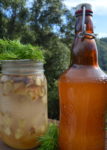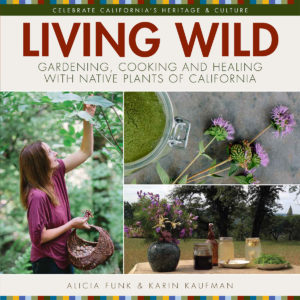May: Fir Tip Soda & Wild Strawberries
May
1 Plantain for Wounds: I covered my plantain leaves in oil in a mason jar and set in the sun to make a wound-healing salve.
2 Oak Nut Marzipan & Doug Fir Iced Tea: I led a hike with a group who won the walk at a fundraiser for the Deer Creek Tribute trail. After identifying native plants in the field, we ended with a picnic finished off with oak nut (acorn) marzipan and refreshing Doug Fir iced tea.
3 Manzanita Cider: I made a big batch for the CNPS-Redbud, native plant sale in Sacramento, along with some Doug Fir iced tea.
4 Pine Pollen Popcorn: I used pine pollen I gathered from Grey Pines last month on my popcorn instead of yeast.
5 Manzanita Cider and Doug Fir Tea
6 Chokecherry Fruit Leather: I dried some last year and I’m finishing off the container. It is a gorgeous fuschia color with a distinctive flavor that I really like. Too bad it has such a terrible name. Goal: Rebrand Chokecherry as Wild Cherry, its other common name.
7 Yerba Santa: Sucked on some more today to freshen the breath and fight off congestion and made tea from the leaves, combined with Yerba Santa.
8 Wildflowers: I gathered wildflowers in abundance, such as alumroot flowers and CA poppy flowers in my backyard and started pressing to use for native plant bookmarks at a kids class later this month.
9 Wild Pea shoots (most of the turning to flowers): I’m still able to gather a few more shoots to use in our nightly salad, but this is the end of the season for them.
10 Fir tips: It is impossible to have enough of these amazingly delicious, vitamin-c-filled tips. I’m gathering and freezing for future use.
11 Manzanita cider; Doug Fir iced tea: I made big batches for the family to drink, storing them in mason jars in the refrigerator.
12 Cattails: Gathered the “hearts” by pulling straight up on the center shoots and added to our salad.
13 Wild Strawberries: I gathered a multitude of tiny, flavorful wild strawberries. I planted them outside the house a few years ago and now they are a beautiful groundcover, covered with delicious berries that the kids love to help pick and eat.
14 Raw Wild Food Bar with Wild Strawberries: I made this recipe from Matt Berry’s recipe in my Living Wild book and took photos for a non-gmo cookbook. I used Oak Nut (acorn) flour, ground walnuts from the garden, manzanita sugar, elderflowers and local honey, mixed together, frozen and then topped with wild strawberries.
15 Fir Tips: Gathered more tips so we are set on tea for the year for the family to rehydrate this summer and for classes and events.
16 Forest Charter School, Wild Food Walk: I took the kids from my daughter’s school, Forest Charter, out for an adventure hike. We identified native plants, practiced cracking acorns and learning how to turn them into flour, and then ended the day sipping on Douglas Fir Tip tea and Manzanita Cider. We had 42 kids, so my colleagues Karouna Thompson and Matt Berry each led a group through the woods.
17 Chokecherry Jam: Our family is eating up the last jar I had saved of Chokecherry jam. The bushes I planted were covered with flowers this year for the first time after several years and the berries are starting to form. Hopefully, I’ll have easy access to make more jam this summer. Goal: Gather more chokecherries from my own backyard bushes this summer.
18 Elderberry syrup. I made some syrup from dried Elderberries, simmered in water for 20 minutes and then strained and sweetened with honey. Watered down and served with ice, it was delicious! I felt like I was fighting off a cold, and noticed how much better I felt after a cup.
19 Soil Born Farms: I taught a class for “A Day at the Farm” at Soil Born Farms in Rancho Cordova, a non-profit group partnered with the Sacramento coop and the California Native Plant Nursery, Elderberry Farms. They are an amazing resource for the community to learn about farming and to see and purchase for the home garden, many of our native plants. After a wild food walk at the farm and tasting of Manzanita Cider, Chokecherry Jam and Oak Nut Marzipan under the trees, we made native plant bookmarks with the kids.
20 Elderflowers: I found a location in town that had some, at the recommendation of someone on the local food coalition. My daughter had to climb under a giant Serviceberry shrub and then climb up the Elderberry tree to gather the flowers and then carefully pass them out to me before attempting to come back out the way she went in. She “earned” her wildcrafting gold star today!
21 Yerba Santa: I’m still fighting off some congestion today so I gathered and sucked on a handful of Yerba Santa leaves. The flowers are in bloom right now and the butterflies love it. My horse, on the other hand, wanted nothing to do with the Yerba Santa and just sniffed it and immediately turned away to look for something tastier. I guess he isn’t congested.
22 Ginger “bug”: Created an elderberry soda and a ginger bug , or starter, with the expert advice of Anna Wereditsch, L.Ac. The starter will be ready in a week and useful for making probiotic beverages from any native juice or tea. Here is the elderberry soda recipe, which I’ll add to the next edition of Living Wild.
ELDERBERRY SODA INGREDIENTS
1 cup dried or 2 cups fresh elderberries
6 cups water
1 ½ cup raw honey or 1 cup organic, unrefined cane sugar
2 Flip top bottles (750 ml)
GINGER BUG INGREDIENTS
1 quart jar filled with filtered water
2 tsp sugar, daily for 7 days
2 tsp freshly chopped ginger, daily for 7 days
Cloth cover for quart jar with rubber band or plastic lid
MAKING A GINGER “BUG” (STARTER)
Make ginger bug 1 week ahead.
– Put all ingredients into a quart jar and fill to the top with filtered water.
– Daily, for 7 days, feed your bug 2 teaspoons sugar and 2 teaspoons chopped ginger. Keep jar covered.
– When bubbles form and start to make sounds, the bug is ready. Strain out the amount needed to make soda and reserve ¼ cup of liquid with ginger pieces for a new bug.
Note: To make a new bug in just 3-5 days, add the ingredients to ¼ cup reserved starter and follow method again.
MAKING ELDERBERRY SODA
Elderberry “soda” is a digestive aide that supports immune system health.
– Bring 4 cups water, 1 ½ cup honey or 1 sugar and 2 cups dried or fresh elderberries to a boil. Turn off heat and let steep until cool.
– Mix 1 cup strained ginger bug per 1 quart strained Elderberry soda, pour into flip top bottles and seal.
– Let sit in warm location for 2 – 5 days and test flavor. If desired, let sit longer to create more carbonation and less sweetness. Open lids once a day to let air out of bottles.
– Keep refrigerated. Strain upon serving.
23 Bay leaves: Gathered California Bay leaves to use as flavoring for soup and for a university in New York that is doing testing on the compounds in the leaves that show promise for headaches.
24 Feeding my Ginger Bug: Well, despite the strange name, I’ve been diligently feeding my bug, 2 teaspoons of sugar and 2 teaspoons of ginger each day. It only took a few days for it to start bubbling. I found it worked well to cover the bug with the mason jar top, without screwing on the lid. When I carefully let air out of my elderberry soda today, it started to bubble up from all of the carbonation. I quickly closed it and put it in the refrigerator to slow down the process. My family tasted the soda tonight and it was delicious, with a strong fruity flavor. It is a wonderful substitute for wine with dinner. I’m going to keep my bug going for a week and then try making Doug Fir soda and more Elderberry soda.
 25 Oak Nut crust with fresh cherries from our garden: I made this absolutely delicious pie, but then realized that I hadn’t leached my acorns long enough. I can’t believe I was in such a hurry that I didn’t taste enough of it and just assumed it was ready. Goal: Grind into finer pieces before leaching so the process goes faster and sample the largest piece to make sure it isn’t bitter, before drying.
25 Oak Nut crust with fresh cherries from our garden: I made this absolutely delicious pie, but then realized that I hadn’t leached my acorns long enough. I can’t believe I was in such a hurry that I didn’t taste enough of it and just assumed it was ready. Goal: Grind into finer pieces before leaching so the process goes faster and sample the largest piece to make sure it isn’t bitter, before drying.
26 Poison Oak Away & Bug Away: Make poison oak away for external use with manzanita leaf as main ingredient to treat poison oak on my arm and make for the community. I’m making Bug Away even stronger now, using more Mugwort.
27 Yarrow Flowers: Gathered and started drying. I will use them for fevers when the kids get them in the fall, but this summer, I plan to brew up some Yarrow ale!
28 Ceanothus and Mint tea: I gathered the native Sierra Mint from a location by the creek. I steeped with Ceanothus (C. integerrimus) and kept refrigerated for a refreshing mid-afternoon treat.
29 Mock Orange Soap: I finally tested making soap from the leaves of Mock Orange. If you crush the leaves between your hands with a little water and rub vigorously, it creates a bubbly soap.
30 Oak Nut Flour: I need to make more Oak Nut flour…I’m going to carefully track the time and taste it thoroughly before drying.
31 Doug Fir Soda: I’m so excited to use my “ginger bug” to create a Doug Fir soda. I made the juice and added the fermented bug, according to Anna Wereditch’s recipe in my Living Wild book. It is taking a few days, but in this warm weather, the fermentation is happening really quick.














